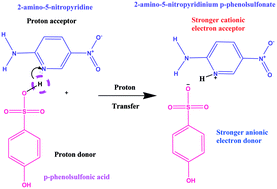Synthesis, crystal growth, physicochemical properties and quantum chemical investigations of a D–π–A type organic single crystal: 2-amino-5-nitropyridinium p-phenolsulfonate (2A5NPP) for nonlinear optical (NLO) applications†
Abstract
Efficient organic nonlinear optical (NLO) 2-amino-5-nitropyridinium p-phenolsulfonate (2A5NPP) single crystals have been grown by slow cooling method using methanol as a solvent. Single crystal X-ray diffraction (SXRD) analysis revealed the unit cell parameters of the grown crystal. The morphology of the grown crystal was identified by single crystal XRD analysis as well. The crystallinity of the title crystal was studied by powder X-ray diffraction (PXRD) analysis. The presence of functional groups was determined by FTIR spectral analysis. The optical transmittance revealed that the grown crystal is transparent in the visible and NIR region with a lower cutoff wavelength of 408 nm. The chemical etching analysis showed that the grown crystal has a lower etch pit density (EPD). The title compound is thermally stable up to 200 °C, as assessed by thermogravimetric (TG) and differential thermal analysis (DTA). The photocurrent (Ip) and dark current (Id) values were found to be 5.3 × 10−11 A and 3.3 × 10−11 A at 50 V, respectively, by photoconductivity analysis. A dielectric study was carried out to find the distribution of charges within the crystal. Theoretical calculations were performed using the B3LYP/6-311++G(d,p) level basis set. The structural parameters of 2A5NPP were studied using the DFT method and the calculated results were compared with the experimental values. The charge transfer characteristic of the title compound was studied by frontier molecular orbital (FMO) analysis. The first-order hyperpolarizability of the 2A5NPP molecule was found to be 2.9 × 10−29 e.s.u, which is 37 times higher compared to the reference urea molecule. The Mulliken charge of the obtained molecule was theoretically analyzed. Hydrogen bonding of the obtained molecule was confirmed by NBO analysis. The Kurtz–Perry powder technique was used to evaluate the second harmonic generation (SHG) efficiency of the title crystal and it was found to be 22 times that of the reference KDP material.



 Please wait while we load your content...
Please wait while we load your content...